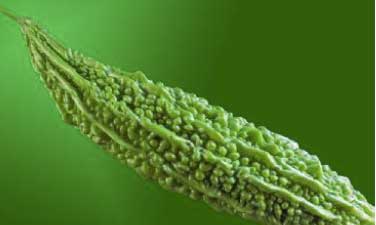|
March 13, 2009
Source:
AVRDC - The World Vegetable
Center Newsletter
 Bitter
gourd (Momordica charantia) is regarded as one of the
world's major vegetable crops and has great economic importance.
It also is a promising candidate as a remedy that can help
millions in the developing world who suffer from metabolic
disorders such as type-2 diabetes. These positive features may
make bitter gourd look like an all-purpose crop; however, to be
successful on a global scale, this indigenous crop requires
attention from breeders as well as production system
specialists. Bitter
gourd (Momordica charantia) is regarded as one of the
world's major vegetable crops and has great economic importance.
It also is a promising candidate as a remedy that can help
millions in the developing world who suffer from metabolic
disorders such as type-2 diabetes. These positive features may
make bitter gourd look like an all-purpose crop; however, to be
successful on a global scale, this indigenous crop requires
attention from breeders as well as production system
specialists.
A traditional vegetable grown throughout tropical and
subtropical Asia, bitter gourd is planted on more than 60,000 ha
annually but major insect-transmitted diseases such as Cucurbit
aphid-borne yellow virus (CABYC), Papaya ringspot virus (PRSV),
and Zucchini yellow mosaic virus (ZYMV) are spreading quickly,
causing significant yield reductions. Fusarium wilt, powdery
mildew, and bacterial wilt also cause considerable damage.
Breeding bitter gourd with resistance or tolerance to diseases
is a promising approach, says Dr. Zhanyong Sun, who is leading
the cucurbit program at AVRDC The World Vegetable Center.
Through disease resistance breeding, private sector researchers
in the Philippines were able to develop Namamarako, a
variety resistant to CNM, a new emerging virus that is a strain
of CABYV. This hybrid yields well even during times of high
virus incidence.
With 302 accessions listed in its current inventory, AVRDC's
Momordica collection is of interest for research cooperation
with partners in the private sector, says Dr. Sun. But it's
important to carry out broader research. We
simply don't know enough about the diseases and insects that
affect bitter gourd, the most successful cultural practices, and
the most promising pest management strategies. As Dr. Sun can
attest, researching indigenous vegetables is an exploration of
the unknown and involves a lot of pioneering work.
Together with AVRDC's Asian Regional Center in Bangkok, Dr. Sun
hopes to conduct an in-depth survey and analysis in the region
to identify varieties that are disease resistant and adapted to
different agroecological conditions. Researchers will not have
to be concerned about one issue: climate change. Bitter gourd
performs even better under hot tropical conditions. |
|